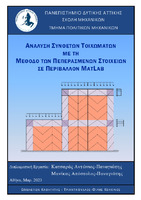| dc.contributor.advisor | Κόκκινος, Φίλης-Τριαντάφυλλος | |
| dc.contributor.author | Κατσαράς, Αντώνιος-Παναγιώτης | |
| dc.contributor.author | Μανίκας, Απόστολος-Παναγιώτης | |
| dc.date.accessioned | 2023-05-02T14:02:02Z | |
| dc.date.available | 2023-05-02T14:02:02Z | |
| dc.date.issued | 2023-04 | |
| dc.identifier.uri | https://polynoe.lib.uniwa.gr/xmlui/handle/11400/4294 | |
| dc.identifier.uri | http://dx.doi.org/10.26265/polynoe-4133 | |
| dc.description.abstract | Στην παρούσα διπλωματική εργασία επιλύεται το πρόβλημα της επίπεδης ελαστικότητας και συγκεκριμένα η περίπτωση της επίπεδης έντασης. Η αριθμητική ανάλυση γίνεται με τη μέθοδο των πεπερασμένων στοιχείων, η οποία προγραμματίζεται με τη MatLab. Το πρώτο κεφάλαιο αποτελεί την εισαγωγή στην επίπεδη ελαστικότητα όπου γίνεται λόγος για τις παραμορφώσεις, τις εξισώσεις ισορροπίας και τις συνοριακές συνθήκες του φορέα. Στο δεύτερο κεφάλαιο περιγράφεται η μέθοδος των πεπερασμένων στοιχείων και η ανάπτυξη των διαφορικών εξισώσεων για τα τριγωνικά στοιχεία τριών κόμβων που επιλέχθηκαν για την επίλυση του προβλήματος. Έπειτα στο τρίτο κεφάλαιο στήθηκε το μαθηματικό προσομοίωμα των πεπερασμένων τριγωνικών στοιχείων όπου αναλύονται διεξοδικά τα στοιχεία των μητρώων στιβαρότητας και επικόμβιων δράσεων. Στο κεφάλαιο 4 γίνεται μια σύντομη περιγραφή της γλώσσας προγραμματισμού MatLab όπου επιλέχθηκε για τη μεταφορά του μαθηματικού μοντέλου σε προγραμματιστικό περιβάλλον. Όπως προαναφέρθηκε, όλη η μέθοδος προγραμματίστηκε σε περιβάλλον MatLab οπότε στο πέμπτο κεφάλαιο επεξηγείτε ο κώδικας για την ανάλυση σύνθετων τοιχωμάτων. Στο έκτο κεφάλαιο παρουσιάζονται εφαρμογές αριθμητικής ανάλυσης επίπεδων φορέων με μοντέλο τριγωνικών πεπερασμένων στοιχείων και συγκεκριμένα για την ανάλυση ενός σύνθετου πλαισιωτού τοιχώματος όπου εξετάζονται δύο περιπτώσεις (με τοιχοπλήρωση και χωρίς). Τελικά, στο έβδομο κεφάλαιο ελέγχεται η επιρροή της τοιχοπλήρωσης στην ακαμψία του πλαισιωτού τοιχώματος με τη σύγκριση των αποτελεσμάτων των δύο περιπτώσεων. | el |
| dc.format.extent | 122 | el |
| dc.language.iso | el | el |
| dc.publisher | Πανεπιστήμιο Δυτικής Αττικής | el |
| dc.rights | Αναφορά Δημιουργού - Μη Εμπορική Χρήση - Παρόμοια Διανομή 4.0 Διεθνές | * |
| dc.rights | Attribution-NonCommercial-NoDerivatives 4.0 Διεθνές | * |
| dc.rights.uri | http://creativecommons.org/licenses/by-nc-nd/4.0/ | * |
| dc.subject | Πεπερασμένα στοιχεία | el |
| dc.subject | MATLAB | el |
| dc.subject | Επίπεδη ελαστικότητα | el |
| dc.subject | Πεπερασμένα τριγωνικά στοιχεία | el |
| dc.subject | Πλαισιωτό τοίχωμα | el |
| dc.subject | Μετακινήσεις κόμβων | el |
| dc.title | Ανάλυση σύνθετων τοιχωμάτων με τη μέθοδο των πεπερασμένων στοιχείων σε περιβάλλον MatLab | el |
| dc.title.alternative | Analysis of composite shear walls with the finite element method using MatLab | el |
| dc.type | Διπλωματική εργασία | el |
| dc.contributor.committee | Δενεζάκη, Σταυρούλα | |
| dc.contributor.committee | Pnevmatikos, Nikolaos | |
| dc.contributor.faculty | Σχολή Μηχανικών | el |
| dc.contributor.department | Τμήμα Πολιτικών Μηχανικών | el |
| dc.description.abstracttranslated | The dissertation at hand analyses the problem of plane elasticity and specifically the case of plane stress. The Finite Element Method (FEM) has been adopted for the numerical analysis of the problem and the program code was written in MatLab. The first chapter consists of an introduction to plane elasticity where deformations, equilibrium equations and boundary conditions of the body are discussed. The second chapter describes the finite element method and the development of the differential equations for the three-node triangular elements chosen to solve the problem. Next, in the third chapter, the mathematical simulation of the finite triangular elements is set up, where the elements of the stiffness matrix and the force vector are thoroughly analyzed. In chapter 4 there is a brief description of the MatLab programming language, which was chosen to implement the mathematical model to a programming environment. As mentioned above, the method has been programmed in a MatLab environment. For this reason, the code for the analysis of composite walls is described in the fifth chapter. In the sixth chapter, applications of numerical analysis of planar structures with triangular finite element modeling are presented in an attempt to carry out the analysis of a composite frame with in-fill wall. Two cases are inspected, one with in-fill wall and one without. The dissertation concludes in the seventh chapter by presenting the influence of in-fill wall on the stiffness of the composite frame and comparing the results of the aforementioned two cases. | el |


